|
I have been engaged in TAO project as a Postdoctoral fellow since 2009. From August 1, 2012, I was assigned to Pontificia Universidad Católica de Chile. Currently I am involved in the work of the TAO project, such as miniTAO observation, while developing near-infrared spectroscopy equipment / imaging equipment at Pontificia Universidad Católica de Chile.
Pontificia Universidad Católica de Chile has 125 years of history since its establishment and it is one of the top universities in Chile. Especially, it is highly evaluated in the fields such as medicine, law, theology and natural science. The university had exchanges with TAO projects through the project’s activities in Chile for some time. Then, last year, a post for a researcher was newly established in the university, under an agreement with the University of Tokyo, and I was fortunate to be assigned to the post.
Located in the southern part of the capital city of Santiago City, San Joaquin Campus is the main campus of Pontificia Universidad Católica de Chile with a large site of about 700 meters square. The buildings are modern with very rich greenery such as trees, lawns and flower beds which makes a pleasant environment. As the name suggests, it is a Catholic university. However, in aspect of conducting research, many people are working and studying with academic vibrancy which make the environment comparable to Japanese universities. There are more than 50 staffs and students in the building of astronomy and astrophysics department where my room is located. Lively research activities such as seminars and colloquiums are being held.
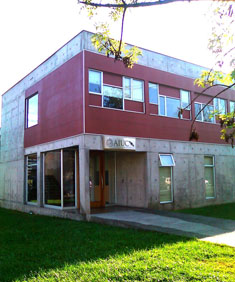
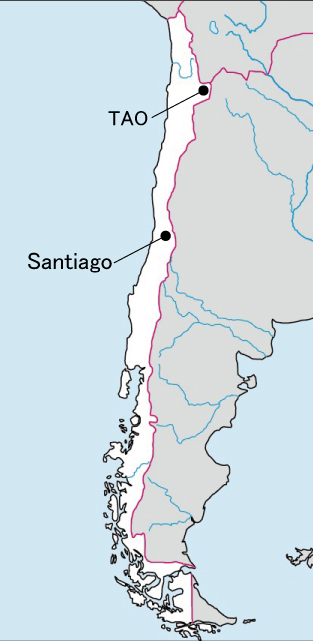
(Left) Exterior view of the Technology center of Pontificia Universidad Católica de Chile, (Right) Location of TAO, and Santiago where the university has situated.
In Chile, there are a number of front-line observation facilities based on the capital of Europe, the United States and Japan at present; such as ALMA (Atacama Large Millimeter/ submillimeter Array) that has finally completed this year, and VLT which holds 8 m telescope, same as Subaru, but even 4 of them. The Chilean astronomy community is very lively to live up to the forefront of astronomy by taking part of its observation time instead of accepting these facilities and raising scientific results. Also, they are not intend to just rely on foreign capitals, but have enthusiasm to learn cutting-edge technologies and make them for self-sustaining.
Currently we are reevaluating the basic performance of a spectrometer and a camera that we received from Arcetri Astrophysical Observatory in Italy and making a mount to attach to our telescope. Both instruments have a detector named NICMOS 3, and observation can be performed in the wavelength band of 1.1 - 2.4 μm. In addition, as a new technical element, we are trying to guide the star's light to a near-infrared spectrometer using optical fiber.By using optical fiber, connection to the telescope becomes easy and the versatility of the device is improved, but the characteristics of the fiber in the near infrared have not been studied much so far. We will verify this with a small scale device and if possible, we plan to apply it to large equipment as well. In addition, we are also aiming to construct an observation system using a commercially available near-infrared camera (Xeva 1.7) so that it can perform near infrared observation more cheaply and easily.
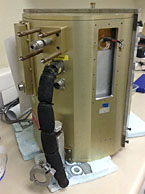
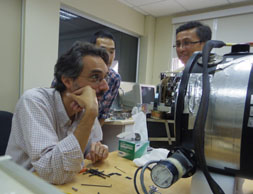
(Left) Near infrared imaging camera, (right) Near infrared spectroscope opening operation Scenery
Also, promotion of the TAO project is also one of my jobs. Currently, I participate in the observation of miniTAO telescope which is conducted twice a year, for about two months each, and I do maintenance, observation operation etc. of telescope and instruments. Eventually, it would be wonderful if we could observe Atacama's night sky with a miniTAO telescope equipped with observation instruments developed at Pontificia Universidad Católica de Chile. In the future, construction of the TAO 6.5 m telescope and Atacama research facility will also proceed. I would like to contribute in aspect of further consolidate cooperation system with Catotica University as a foothold for the success of TAO project.
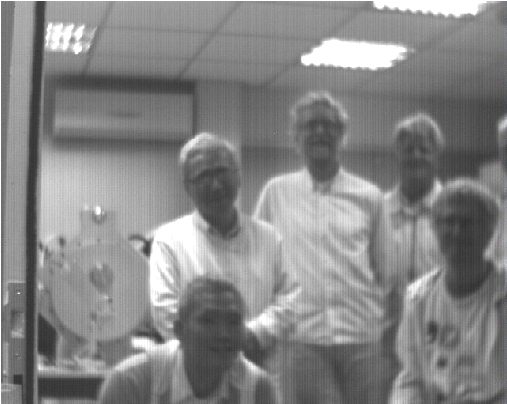
Laboratory member taken with a commercially available near infrared camera
Nearly a year has passed since I came to Chile. I came alone to an environment far from Japan, and there were lots of hardships and surprises. I looked around here and there for things I can easily purchase in convenient stores if it is in Japan. Tempura and ramen became excessively missed. Security in Chile is said to be the best in South America, even though there was a riot of young people just across the apartment once. However, most people are friendly and kind, and you can get most of the nice foods and clothing. You can also take a cultural stimulus by feeling how Chilean people look at Japan from outside. Until the term of office ends, I would like to absorb various things at best in this environment, and to apply it to my research and my future life.
KOSHIDA, Shintaro
Center of Astro Engineering and Department of Electrical Engineering,
Pontificia Universidad Catolica de Chile
Postdoctoral fellow
|



